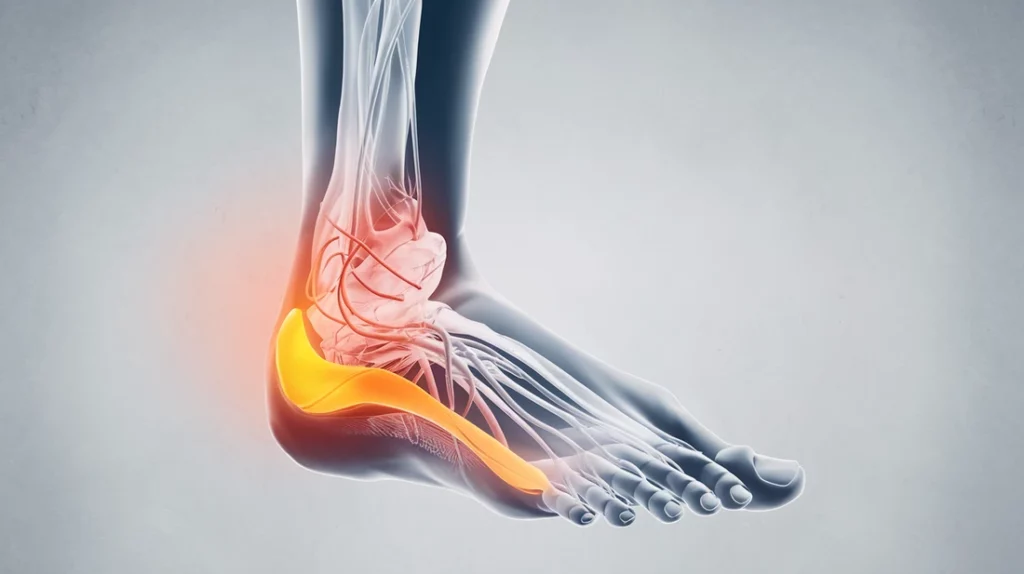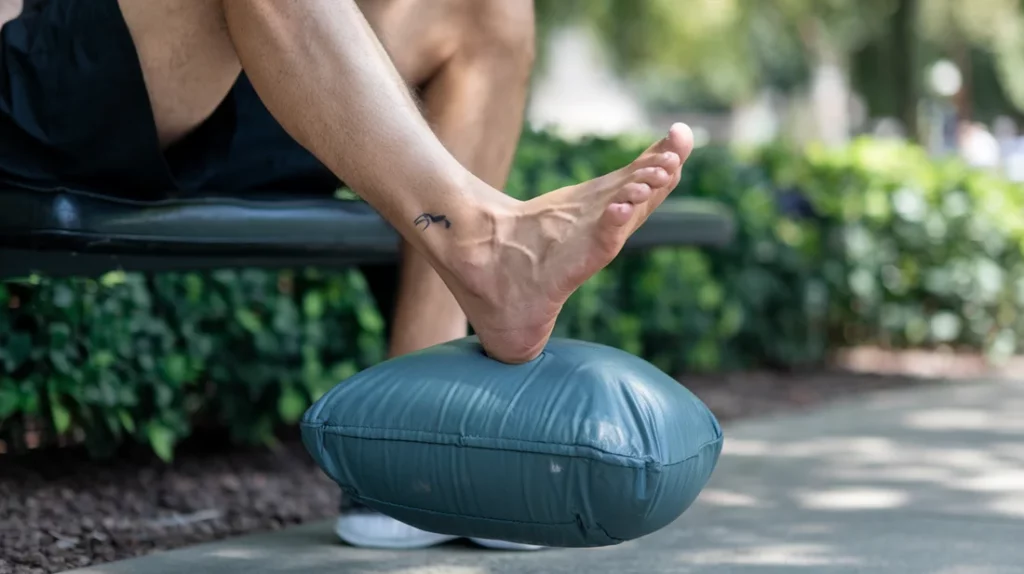You know the feeling: that sharp, stabbing pain in your heel with each step, especially when you get out of bed in the morning.
Plantar fasciitis can be an incredibly frustrating condition, that can limit your mobility, and impact your daily life.
Most people try to treat it with traditional treatments, such as insoles or stretching, but this often falls short of providing long-lasting relief, as it does not address the root cause of the problem, which is often weakness in the surrounding muscles.

That’s where a different approach is needed, one that focuses on strengthening the muscles that support the plantar fascia.
Enter sandbag training for plantar fasciitis – a powerful, versatile, and accessible method to build strength in your feet, ankles, core and legs, while also relieving your pain.
This method focuses on strengthening the supporting muscles, which will help to provide you with long lasting relief, and help you to take control of your own health.
This guide will show you how to use sandbag exercises safely and effectively to strengthen the muscles that support the plantar fascia, and to reduce the pain that you are experiencing.
You will learn about the best exercises, routines, and safety advice to help you on your journey.
Get ready to discover a new way to address your plantar fasciitis and to take back your comfort and your mobility.
Disclaimer: It is very important that you consult with a healthcare professional, or physical therapist, before starting any new exercise program, especially if you have plantar fasciitis. This blog post is for informational purposes only and does not constitute medical advice. The exercises and advice provided are not intended to be a replacement for medical treatment and should be used at your own risk.
Understanding Plantar Fasciitis and its Underlying Causes
To understand how sandbag training can help, it is important to first understand the underlying causes of plantar fasciitis.
Let’s explore what this condition is, and why traditional treatment methods are often not effective.

What is Plantar Fasciitis?
- Location: Plantar fasciitis is a common condition that affects the plantar fascia, a thick band of tissue that runs along the bottom of your foot from your heel to your toes.
- Symptoms: Common symptoms include:
- Sharp, stabbing pain in your heel, especially when you take your first steps in the morning or after a long period of rest.
- Pain that may worsen after exercise, or after standing for prolonged periods.
- Stiffness in the heel and arch of your foot.
Common Causes
Plantar fasciitis is often caused by a combination of factors, including:
- Weak Foot Muscles: Weak muscles in the feet do not provide the support the plantar fascia needs, and can increase the stress on it, which can lead to inflammation and pain.
- Tight Calf Muscles: Tight calf muscles pull on the plantar fascia, which will increase the tension, and may cause pain.
- Poor Core Strength: Poor core strength may also contribute to plantar fasciitis, as the core plays a vital role in stability and movement.
- Improper Biomechanics: Improper walking or running mechanics can also lead to excess stress on the plantar fascia, which may cause pain. This may be due to overpronation, or other issues in the gait cycle.
Why Strengthening Supporting Muscles Is Key
- Target the Cause, Not Just the Symptom: To get effective long term relief from plantar fasciitis, it is vital to address the underlying causes, and not just to focus on the symptoms. Traditional treatment options may provide some relief, but they do not focus on strengthening the supporting muscles, which is what is needed for lasting results.
- Long-Term Relief: Strengthening the muscles around your foot, ankle, and calf, will help to take the load of the plantar fascia. Improving the strength of your core will also provide support for your back, which will help to stabilize your whole body and allow for correct movement patterns.
- Improve Biomechanics: You will also be able to improve the biomechanics of your gait, to further reduce the chances of re-injury.
How Sandbag Training Targets Plantar Fasciitis
To truly understand how sandbag training for plantar fasciitis works, let’s explore the key scientific principles behind this approach.
This section will explain how sandbags are different from other training methods, and why they are so effective for plantar fasciitis relief:
Functional Strength
- Real-World Application: Sandbag training is designed to build a type of functional strength that mimics real-world movements. Unlike traditional exercises that target isolated muscles, sandbags engage your entire body in a more natural way.
- Full Body Engagement: With every sandbag exercise, your core, legs, back, and foot muscles are all working together to provide support, and stability, for your entire body. This means that the workout is more efficient, and more effective at strengthening the muscles that you need, in a coordinated manner.
- Dynamic Movements: By performing dynamic movements, such as lunges and carries, you are able to transfer that strength to your daily activities, such as walking, or standing for prolonged periods, whilst also improving your overall mobility and function.
Targeted Muscle Strengthening
- Calf Muscles: Sandbag exercises, such as calf raises can help to strengthen your calf muscles, and improve the flexibility of the ankle, and reduce the tension on the plantar fascia.
- Foot Muscles: Exercises such as toe raises, and heel raises help to strengthen the muscles in your feet, which will help to provide support for your plantar fascia, and reduce the chance of injury.
- Core Muscles: By performing exercises such as planks, and carries you will be able to strengthen your core muscles, which is essential for stability, balance and good posture, which will all help to reduce the stress on your plantar fascia.
- Connecting Muscles: By strengthening all of the muscles that are connected to your feet, such as your calves, quads, hamstrings and glutes, the pressure will be taken off of your foot.
Improved Stability and Alignment
- Balance and Control: By using sandbags, you will be able to improve your balance, and foot stability, as the unstable weight of the sandbag, will force you to use your core, feet and legs, to maintain balance, and stability during all exercises.
- Reduced Stress: This improved stability and alignment will help to reduce the overall stress that is being placed on your plantar fascia, which will ultimately reduce pain and inflammation, and improve your mobility. Research has also demonstrated that unstable load training increases core muscle activation, which is essential for building strength, and stability, to reduce stress on the plantar fascia.
Safe and Effective Sandbag Exercises for Plantar Fasciitis
These sandbag exercises for plantar fasciitis are designed to be safe and effective at strengthening your core and back, while also providing pain relief.
Always start slowly and focus on maintaining proper form over lifting heavy weight, and listen to your body during each movement.
Remember to consult with a professional if you are new to training, or if you have an underlying condition.
| Exercise | Instructions | Benefits for Plantar Fasciitis | Beyond the Basics | Sets | Reps |
| Modified Sandbag Deadlifts | Lift the sandbag off the floor while keeping your back straight. Focus on core engagement, and glutes, and keep the movement slow and controlled. | Strengthens the core, back and glutes, providing a solid foundation for spinal support, and functional strength. | Try performing this exercise from a raised platform, or by adding a pause at the top of the lift. | 2-3 | 6-8, or as tolerated |
| Sandbag Rows | Bend at the hips, grab the sandbag, and pull it toward your chest, while keeping your back straight. Use your back muscles to generate the force rather than your arms. | Strengthens the back muscles, which improves posture and stability, and helps to engage and strengthen the core muscles. | Use different grips, and try doing the rows on an incline to make the exercise more challenging. | 2-3 | 8-10, or as tolerated |
| Sandbag Carries (Various) | Walk forward, while carrying the sandbag in front of you, on your shoulder, or in a bear hug. Engage your core and try to keep your body straight. | Enhances core strength, back strength, stability and endurance. | Try walking sideways, backwards, or on uneven surfaces. Vary the weight of the sandbag. | 2-3 | 30-60 seconds, or as tolerated. |
| Sandbag Planks (Variations) | Hold a standard plank, whilst holding a sandbag or with a sandbag on your back. Also try variations, such as plank rows, or shoulder taps. | Strengthens core muscles, and improves stability and endurance, which are essential for back support. | You can vary this exercise by adding side planks, plank rows, or plank shoulder taps. | 2-3 | 30-60 seconds, or as tolerated. |
| Sandbag Calf Raises | Stand with your feet shoulder-width apart, holding the sandbag in front of you. Rise up onto your toes, engaging your calf muscles. Slowly lower back down to the starting position. | Strengthens your calf muscles, which helps to improve ankle flexibility, and reduces the tension on the plantar fascia. | You can vary this by doing single-leg calf raises, by standing with your toes on a platform, or by using a heavier weight. | 2-3 | 10-15 reps, or as tolerated |
| Sandbag Toe Raises | Sit in a chair, and place the sandbag on your toes. Engage your foot muscles, and lift your toes up off the floor. | Strengthens the intrinsic foot muscles, which will support the arch of your foot, and the plantar fascia, and help to reduce pain. | Vary the position of your feet, and also vary the position of the sandbag. | 2-3 | 10-15 reps, or as tolerated |
| Sandbag Heel Raises | Sit in a chair, and place your feet flat on the ground. Put the sandbag on the heels of your foot, and lift the heel off the ground. | Strengthens the muscles around your heel, will help to improve flexibility and provide support for the plantar fascia. | You can try standing up, and doing a full heel raise, or adding a pause at the top of the lift. | 2-3 | 10-15 reps, or as tolerated |
Sandbag Calf Raises
- Instructions: Stand with your feet shoulder-width apart, holding the sandbag in front of you. Rise up onto your toes, engaging your calf muscles. Slowly lower back down to the starting position. The movement should be slow and controlled.
- Benefits for Plantar Fasciitis: Strengthens your calf muscles, which helps to improve ankle flexibility, and reduces the tension on the plantar fascia.
- Safety Tips: Keep your back straight and core engaged, and avoid using momentum.
- Beyond the Basics: You can vary this by doing single-leg calf raises, by standing with your toes on a platform, or by using a heavier weight.
- Sets and Reps: 2-3 sets of 10-15 reps, or as tolerated.
Sandbag Toe Raises

- Instructions: Sit in a chair, and place the sandbag on your toes. Engage your foot muscles, and lift your toes up off the floor, and lift the sandbag as high as you can. Hold this position for a few seconds, and slowly lower them back to the starting position.
- Benefits for Plantar Fasciitis: Strengthens the intrinsic foot muscles, which will support the arch of your foot, and the plantar fascia, and help to reduce pain.
- Safety Tips: Do not round your back, and make sure to engage your core muscles. You should also use a weight that is suitable for you, and not too heavy, to reduce the chance of overstraining the muscles in your feet.
- Beyond the Basics: Vary the position of your feet, and also vary the position of the sandbag, to ensure that you are challenging the foot muscles.
- Sets and Reps: 2-3 sets of 10-15 reps, or as tolerated.
Sandbag Heel Raises
- Instructions: Sit in a chair, and place your feet flat on the ground. Put the sandbag on the heels of your foot, and lift the heel off the ground, engaging the muscles in your foot, and your lower leg. Make sure to hold this position, and lower your heels to the floor in a controlled manner.
- Benefits for Plantar Fasciitis: Strengthening the muscles around your heel, will help to improve flexibility and provide support for the plantar fascia, and reduce tension.
- Safety Tips: The movement should always be slow and controlled, and never train through any pain. If you feel any discomfort, stop immediately.
- Beyond the Basics: To increase the difficulty, you can try standing up, and doing a full heel raise, or adding a pause at the top of the lift. You can also vary the position of the weight, to target the muscles in different ways.
- Sets and Reps: 2-3 sets of 10-15 reps, or as tolerated.
Sandbag Squats (Modified)
- Instructions: Stand with your feet shoulder-width apart, and hold the sandbag in front of your chest. Squat down, pushing your hips back, and bending your knees, but only go down as far as you are comfortable. When you are standing up, ensure that you are engaging your core, and pushing through your heels.
- Benefits for Plantar Fasciitis: Modified squats strengthens the muscles in your legs, core, and back, all of which are important to provide support, and reduce strain on the plantar fascia. This will also improve posture, balance and stability.
- Safety Tips: Do not go down too far into the squat, and keep the movement controlled and slow. Ensure that your core is engaged throughout the exercise, and never round your back. If you feel any pain, stop immediately.
- Beyond the Basics: You can also perform a wall sit whilst holding a sandbag, or try box squats to provide greater variation.
- Sets and Reps: 2-3 sets of 8-10 reps, or as tolerated.
Sandbag Lunges (Modified)

- Instructions: Hold the sandbag in front of you or on your shoulders. Take a step forward with one leg, and bend both knees to 90 degrees. Make sure to keep your core engaged and your back straight. Perform the exercise in a slow and controlled manner, and push back to the start position. You can also perform reverse lunges or lateral lunges, depending on the space and your own requirements.
- Benefits for Plantar Fasciitis: Modified lunges are a good way to strengthen the leg and core muscles, which will provide support for your feet and reduce the strain on your plantar fascia. This exercise will also improve balance and stability.
- Safety Tips: Ensure that you do not let your front knee go past your toes, and do the movement slowly and in a controlled manner. If you feel pain, you must stop immediately.
- Beyond the Basics: If you want to make this more difficult, then add a rotational element, or try step-ups.
- Sets and Reps: 2-3 sets of 8-10 reps per leg, or as tolerated.
Sandbag Carries
- Instructions: Hold the sandbag in front of you, or on one shoulder. You can also try the bear hug hold, or the Zercher carry. Walk forward for a set distance, or time, whilst keeping your core engaged and your back straight.
- Benefits for Plantar Fasciitis: Sandbag carries will help to improve core strength and stability, and they will also help to strengthen the supporting muscles, and improve your balance and endurance.
- Safety Tips: Focus on keeping your back straight, and engaging your core muscles to avoid any injuries.
- Beyond the Basics: Try walking in different directions, including forward, backwards or sideways to provide greater variations.
- Sets and Reps: 2-3 sets of 30-60 seconds, or as tolerated.
Sample Sandbag Workout Plan for Plantar Fasciitis Relief
These sample sandbag workout routines for plantar fasciitis are designed to help you strengthen the muscles that support your plantar fascia, and to reduce the pain, and symptoms that you are experiencing.
Always remember to listen to your body, and never train through pain.
Start slowly, and increase the intensity gradually, as you become more comfortable.
These plans are designed to be used with a focus on specific areas of development, and they are not intended to replace any medical advice that you have received from a healthcare professional.
| Workout Plan | Focus | Exercises | Sets | Reps | Rest Between Sets | Cool Down |
| Beginner Routine | Focus on mastering basic exercises, building strength, and learning to engage your core. | Modified Deadlifts, Sandbag Calf Raises, Sandbag Toe Raises, Sandbag Heel Raises, Sandbag Carries (Front) | 2 | 6-8, 30 seconds | 60-90 seconds | 5-10 minutes of static stretching focusing on the feet, ankles, legs and core |
| Intermediate Routine | Increase the intensity and reps and perform more complex movements with heavier sandbags. | Modified Deadlifts, Sandbag Calf Raises, Sandbag Toe Raises, Sandbag Heel Raises, Sandbag Squats (Variations), Sandbag Lunges (Variations), Sandbag Carries (Various) | 3 | 8-12, 45 seconds | 45-60 seconds | 5-10 minutes of static stretching and gentle movements. |
Beginner Routine – Building a Foundation
- Goal: Master the basic exercises, and start to build a base level of strength and stability, with a focus on proper technique.
- Warm-Up: 5-10 minutes of gentle cardio (such as slow walking) and dynamic stretches such as ankle circles, calf stretches, and toe curls.
- Workout:
- Modified Sandbag Deadlifts: 2 sets of 6-8 reps (focus on form).
- Sandbag Calf Raises: 2 sets of 10-12 reps.
- Sandbag Toe Raises: 2 sets of 10-12 reps.
- Sandbag Heel Raises: 2 sets of 10-12 reps.
- Sandbag Carries (Front): 2 sets of 30 seconds (focus on keeping the back straight and core tight).
- Rest: 60-90 seconds of rest between sets to allow for adequate recovery.
- Cool-Down: 5-10 minutes of static stretching (holding each stretch for 30 seconds), focusing on stretching the feet, ankles, calves, legs and core.
Intermediate Routine – Adding Intensity
- Goal: Increase strength, and start using more complex movements with heavier sandbags, and continue to work on your balance and stability.
- Warm-Up: 5-10 minutes of light cardio, dynamic stretching and mobility exercises.
- Workout:
- Modified Sandbag Deadlifts: 3 sets of 8-10 reps (gradually increase the weight).
- Sandbag Calf Raises: 3 sets of 12-15 reps (try variations such as single leg).
- Sandbag Toe Raises: 3 sets of 12-15 reps.
- Sandbag Heel Raises: 3 sets of 12-15 reps.
- Sandbag Squats (Variations): 3 sets of 8-10 reps (try different variations).
- Sandbag Lunges: 3 sets of 8-10 reps per leg (try different variations).
- Sandbag Carries (Various): 3 sets of 45 seconds (try different variations such as shoulder carries, and carries on one side).
- Rest: 45-60 seconds of rest between sets to allow for adequate recovery.
- Cool-Down: 5-10 minutes of static stretching (holding each stretch for 30 seconds).
Choosing the Right Sandbag for Plantar Fasciitis
Choosing the right sandbag is key to optimizing your training and seeing results on the golf course.
It’s not a one-size-fits-all approach; the ideal sandbag will depend on your specific needs and goals.
Here’s a comprehensive guide to help you select the best sandbag for your sandbag training for plantar fasciitis:
Weight Recommendations
- Start Light: If you are a beginner, start with a lighter sandbag (5-10 lbs), and focus on mastering the proper form and technique for each exercise.
- Gradual Progression: As you get stronger, gradually increase the weight in small increments (2-5 lbs). It is important to make sure you are comfortable with each level of intensity before progressing to the next.
- Adjustable Options: Opt for an adjustable sandbag so you can easily change the weight as needed.
Size and Material
- Comfort: Choose a sandbag that is comfortable to handle and that fits well against your body during carries and other exercises. For this you will need to make sure that you are choosing a size that is suitable for your body.
- Versatility: A medium-sized cylindrical sandbag is often the most versatile option for various exercises. It should be long enough for you to grip and lift it correctly.
- Durability: Look for a sandbag made from high-quality, durable materials that can withstand frequent use. For this, a standard canvas or nylon material will be good.
Handle Types
- Multiple Handles: Look for a sandbag with multiple handles, including reinforced nylon straps or durable rubber grips.
- Strategic Placement: Consider the handle placement. Having handles on the sides and ends of the sandbag will allow you to do a wider range of exercises.
DIY Options
- Old Duffel Bag: An old duffel bag is a good option if you want to create a low cost sandbag. Simply fill it with sand, and tie it up tightly.
- Heavy-Duty Bag: You can also buy a heavy-duty bag with a zipper and fill it up with sand. This will create a durable and versatile sandbag.
- Filler Material: For both types of DIY sandbag, ensure that you use heavy duty garbage bags, or water proof plastic bags as inner liners, to prevent sand from escaping.
Progression, Safety, and Injury Prevention
Sandbag training for plantar fasciitis is a great way to build the muscles that support the plantar fascia, and to reduce pain, and improve mobility.
However, it is important to implement it safely.
Start Slow
Master the Basics: You should always master the proper form, and technique before you increase the weight or intensity.
Gradual Introduction: Gradually introduce new exercises into your routine. Do not try to do too much too soon.
Proper Technique
- Controlled Movements: Focus on doing the exercises in a slow and controlled manner, to ensure that you are engaging the correct muscles and that you are not using momentum.
- Engage Core: Always engage your core muscles, during each exercise, to stabilize your body and to protect your lower back.
Listen to Your Body
- Pay Attention to Pain: Always pay attention to your body, and never train through pain. If you feel any pain, stop the exercises immediately.
- Adequate Rest: Ensure that you are allowing for adequate rest, and that you are not over training. Your body needs rest to recover.
Modifications
- Adjust to Your Needs: You should adjust the exercises to suit your fitness levels, and your limitations. You may have to modify or completely avoid certain exercises.
- Lighter Weight: You may need to perform the exercises with a lighter weight, to ensure that you are maintaining proper form.
- Progression: If you are new to training then you can start with bodyweight movements before progressing to the sandbag exercises.
When to Seek Professional Help
- Medical Advice: If you are unsure if these methods are appropriate for you, then it is important to speak to a qualified medical professional, who is able to give specific and tailored advice.
- Persistent Pain: If you experience any persistent pain or any recurring injuries, then it is important to speak to your doctor or physical therapist.
FAQ (Frequently Asked Questions)
Here are some common questions about using sandbag training for plantar fasciitis and clear, concise answers to each of them:
- Is sandbag training safe for people with plantar fasciitis?
- When done correctly, sandbag training can be a safe and effective way to strengthen your core and back muscles, which will help to alleviate pain. Always prioritize proper form, and start slow with a light weight, and only progress when you are confident and comfortable. If you are unsure, always consult with a healthcare professional before starting any new exercise routine.
- How often should I do sandbag training for plantar fasciitis?
- Start with 2-3 sessions per week, with rest days in between. It is vital that you allow for adequate rest, for your body to recover, and do not train on consecutive days.
- What weight of sandbag should I use for plantar fasciitis?
- Start with a lighter weight (5-10 lbs) and focus on learning the correct form and technique. You can then increase the weight as you get more comfortable. Make sure you can complete all the exercises with good form. You should use a weight that feels challenging, but not too heavy.
- What should I do if I have pain?
- If you experience any sharp or severe pain, during a workout, you must stop immediately. Rest, and consider using an ice pack, to help reduce pain. If you experience recurring pain, then you should consult with a healthcare professional.
- Can sandbag training cure plantar fasciitis?
- While sandbag training can help to relieve pain by strengthening the muscles supporting the plantar fascia, it is not a guaranteed cure, and it will not cure the condition for everyone. It is important to combine training with rest, and any other treatment options that have been recommended by your healthcare professional.
- Will this help with my heel pain?
- Yes, sandbag training can help to reduce heel pain related to plantar fasciitis, by strengthening the supporting muscles, in your calf and feet. You can use exercises such as calf raises, heel raises and toe raises. If the heel pain is caused by other underlying issues, you must consult with a healthcare professional.
Testimonials and Case Studies
While the science of sandbag training for plantar fasciitis is compelling, nothing is as powerful as real-world results.
Here are some testimonials and case studies from individuals who have used sandbag training to manage their symptoms, and to regain control of their life:
Testimonial 1 – From a Person With Chronic Plantar Fasciitis
“I’ve had plantar fasciitis for over a year, and the pain was unbearable, especially in the mornings. Since I started doing sandbag exercises for plantar fasciitis, I have noticed that my heel pain is much more manageable, and I can perform day to day tasks without so much discomfort. My feet feel stronger, and I’m feeling much more confident on the course now!” – Lisa M, Teacher.
- Impact: This testimonial highlights that people can gain relief from their pain.
- Credibility: A quote from an individual that is struggling with the condition will help the reader to relate to the content.
Testimonial 2 – From a Physical Therapist
“As a physical therapist, I always try to give my clients functional exercises to improve their overall health and mobility. I have started to recommend sandbag training for plantar fasciitis to my clients, and I have found that they are all getting a better result, and they are experiencing pain relief. I will continue to use this method of training, as it is a safe and effective way of building strength, flexibility, and improving the biomechanics of the feet and legs.” – Sarah J., Physical Therapist.
- Impact: This testimonial highlights that the method is also used by professionals.
- Credibility: A quote from a physical therapist helps to increase trust in the information being presented.
Case Study – Reduced Heel Pain and Morning Stiffness
- Background: A construction worker, “Tom B”, was experiencing severe heel pain and stiffness, especially when he got up in the morning.
* Action: He started to use sandbag training with an emphasis on exercises such as calf raises, toe raises, and heel raises. - Result: After 10 weeks, he noticed a significant reduction in his pain and stiffness, and he was also able to perform his daily tasks much more comfortably.
- Impact: This shows that sandbag training is useful to reduce the pain, and morning stiffness.
- Real World Application: Shows that this type of training has practical real world applications.
Case Study – Strengthened Arches and Improved Posture
- Background: A nurse, “Emily W,” was experiencing severe arch pain, and struggled to walk for long periods of time.
- Action: After a period of using sandbag exercises she found that she was able to strengthen the muscles in her feet, and that her posture and core strength had improved.
- Result: She was also able to walk for much longer periods, with a lot less pain, and discomfort.
- Impact: Highlights the importance of core strength in the treatment of plantar fasciitis.
- Real World Application: Shows that this method of training helps to improve mobility and reduces pain.
Disclaimer
Important: It is essential that you consult with a qualified healthcare professional, such as a doctor or physical therapist, before starting any new exercise program, particularly if you have been diagnosed with plantar fasciitis or are experiencing heel pain.This blog post is for informational purposes only and does not constitute medical advice. The exercises and advice provided in this article are not intended to replace medical treatment and are to be used at your own risk. The author of this blog post is not responsible for any injuries or harm that may result from performing the exercises outlined in this blog.
Conclusion – Reclaim Your Comfort – Sandbag Training for Plantar Fasciitis
You now have a comprehensive guide on how to manage and address your plantar fasciitis.
By using sandbag training you will build strength, stability, and flexibility, in your lower body and core, and also begin to reduce your pain.
Remember that consistency, proper technique, and listening to your body are the keys to success.
You now have the tools, and knowledge, and you must now take action.
Choose the workout routine that suits you best, and start your journey to a more comfortable and pain-free life.
Your journey to a more comfortable and pain free life starts now. Are you ready to take control?
References
Akuthota, V., & Nadler, S. F. (2004). Core strengthening. Archives of physical medicine and rehabilitation, 85(3 Suppl 1), S86–S92. https://www.archives-pmr.org/article/S0003-9993(03)01235-8/fulltext
Behm, D. G., Leonard, A. M., Young, W. B., Bonsey, J., & McNaughton, L. R. (2010). Trunk muscle electromyographic activity with unstable and unilateral exercises. Journal of Strength and Conditioning Research, 24(9), 2486–2495. review. Journal of Foot and Ankle Surgery, 47(3), 182–195. https://pubmed.ncbi.nlm.nih.gov/15705034/



